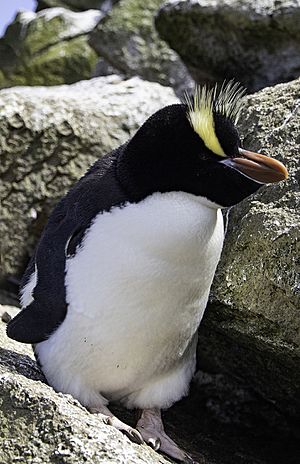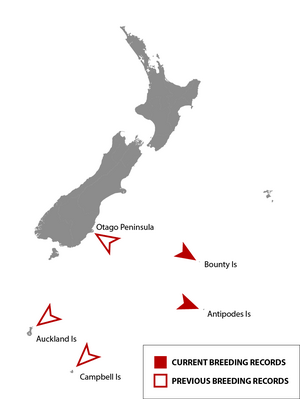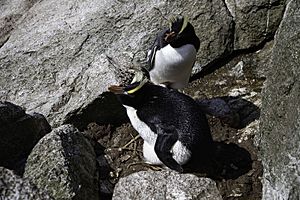Erect-crested penguin facts for kids
Quick facts for kids Erect-crested penguin |
|
|---|---|
 |
|
| On the Proclamation Island, Bounty Islands | |
| Conservation status | |
| Scientific classification | |
| Genus: |
Eudyptes
|
| Species: |
sclateri
|
 |
|
| Distribution (nesting) of the erect-crested penguin | |
The erect-crested penguin (Eudyptes sclateri) is a type of penguin that lives only in the New Zealand area. These penguins breed, or have their babies, only on the Bounty and Antipodes Islands.
This penguin has black feathers on its back and white feathers on its belly. It also has a bright yellow stripe above its eyes that forms a crest. Erect-crested penguins spend the winter months out at sea. We don't know much about their daily lives or how they raise their young. The number of these penguins has gone down a lot in recent years. Because of this, the International Union for the Conservation of Nature has listed them as an "endangered" animal.
Contents
What Do Erect-crested Penguins Look Like?
The erect-crested penguin is a small to medium-sized penguin. It usually stands about 50–70 cm (20–28 in) tall. These penguins weigh between 2.5–6 kg (5.5–13.2 lb).
Male penguins are a little bigger than females. Like most crested penguins, males also have a larger beak. Their backs are bluish-black to very dark black. Their bellies are white. They have a wide, bright yellow stripe above each eye. This stripe goes over the eye and forms a short, upright crest of feathers.
Scientists don't know much about the daily lives of these penguins. It's hard to study them because of where they live. Also, the New Zealand Department of Conservation has strict rules about studying them.
Like other crested penguin species, they probably eat small fish, krill (tiny shrimp-like creatures), and squid. The scientific name for this penguin, sclateri, honors a British zoologist named Philip Lutley Sclater.
Where Do Erect-crested Penguins Live?

Erect-crested penguins make their nests and raise their young on the Bounty Islands and Antipodes Islands. In the past, small groups were also seen breeding on Campbell Island and the Auckland Islands. In the 1940s, a pair was even seen breeding on the Otago Peninsula in mainland New Zealand.
These penguins spend a lot of time at sea. They are at sea before they molt (lose their old feathers) in February and March. They also stay at sea during the winter months, from March to August. Some individual penguins have been found very far away, even near the Falkland Islands. They have also been seen in Argentina, Antarctica, and Australia.
Erect-crested penguins build their nests in large groups called colonies. They like rocky areas. On the Antipodes Islands, they sometimes nest only with their own kind. Other times, they nest alongside Southern Rockhopper penguins. On the Bounty Islands, erect-crested penguins often nest in big mixed colonies with Salvin's albatross birds.
Why Are Erect-crested Penguins Endangered?
The number of erect-crested penguins has dropped a lot since the 1940s. In the late 1970s, scientists thought there were about 230,000 breeding pairs. However, these numbers might not have been completely accurate.
Even so, there is strong proof that their population went down a lot in the second half of the 20th century. Luckily, this decline seems to have slowed down in recent years. Today, scientists believe there are about 150,000 adult erect-crested penguins.
Because their numbers are so low, the erect-crested penguin is listed as an endangered species on the IUCN Red List. This means they are at high risk of becoming extinct. They are also protected under the U.S. Endangered Species Act.
See also
- Pingüino de Sclater para niños (Erect-crested penguin for kids in Spanish)



